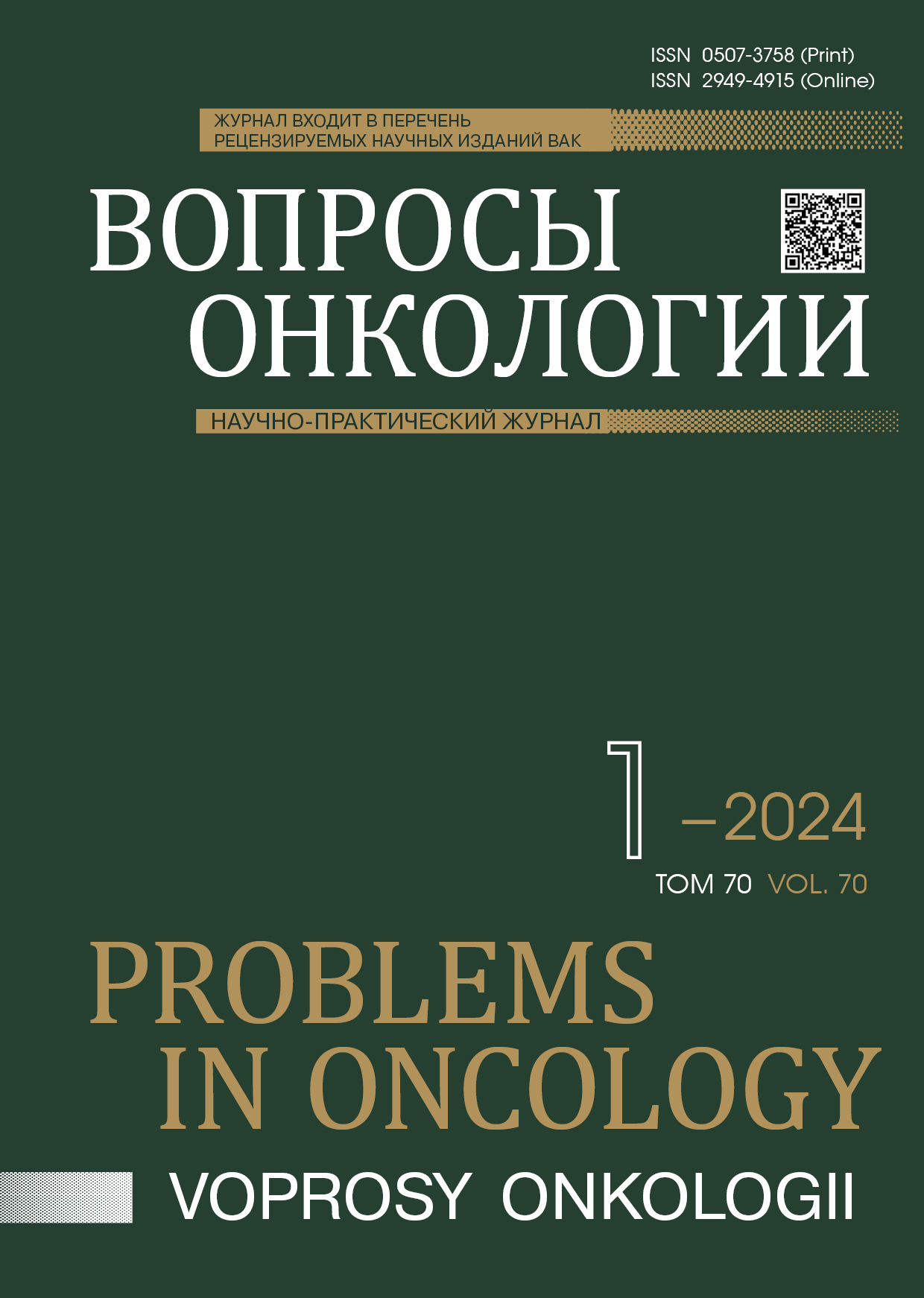Аннотация
Введение. Атипичные тератоид-рабдоидные опухоли (АТРО) являются чрезвычайно редкими агрессивными новообразованиями детского возраста с преимущественной встречаемостью у пациентов до 3 лет и доминирующей локализацией в пределах центральной нервной системы (ЦНС). Несмотря на интенсивные комплексные методы терапии, прогноз у данной категории больных остается неудовлетворительным.
Описание случая. Нами представлен случай агрессивного течения первично-метастатической АТРО в сочетании с глиомой низкой степени злокачественности у пациентки первого года жизни с синдромом предрасположенности к рабдоидным опухолям I типа (наследственной мутацией в гене SMARCB1). Применение комплексной интенсивной противоопухолевой терапии, согласно рекомендациям Медицинского университета Вены (MUV ATRT) и метрономной химиотерапии, сопровождалось длительным эффектом. Тем не менее при последующем стремительном прогрессировании заболевания все попытки лечения оказались безрезультатными, и пациентка скончалась спустя 44 месяца после постановки диагноза.
Библиографические ссылки
Woehrer A, Slavc I, Waldhoer T, et al. Incidence of atypical teratoid/rhabdoid tumors in children: a population-based study by the Austrian Brain Tumor Registry, 1996-2006. Cancer. 2010; 116(24): 5725-32.-DOI: https://doi.org/10.1002/cncr.25540.
Tekautz T.M., Fuller C.E., Blaney S., et al. Atypical teratoid/rhabdoid tumors (ATRT): improved survival in children 3 years of age and older with radiation therapy and high-dose alkylator-based chemotherapy. J Clin Oncol. 2005; 23(7): 1491-9.-DOI: https://doi.org/10.1200/jco.2005.05.187.
Rechberger J.S., Nesvick C.L., Daniels D.J. Atypical teratoid rhabdoid tumor (ATRT): disease mechanisms and potential drug targets. Expert Opinion on Therapeutic Targets. 2022; 26(3): 187-192.-DOI: https://doi.org/10.1080/14728222.2022.2040017.
Bourdeaut F., Lequin D., Brugières L., et al. Frequent hSNF5/INI1 germline mutations in patients with rhabdoid tumor. Clin Cancer Res. 2011; 17(1): 31-38.-DOI: https://doi.org/10.1158/1078-0432.CCR-10-1795.
Del Baldo G., Carta R., Alessi I., et al. Rhabdoid tumor predisposition syndrome: from clinical suspicion to general management. Front Oncol. 2021; 11: 586288.-DOI: https://doi.org/10.3389/fonc.2021.586288.
Nemes K., Johann P.D., Steinbügl M., et al. Infants and newborns with atypical teratoid rhabdoid tumors (ATRT) and extracranial malignant rhabdoid tumors (eMRT) in the EU-RHAB registry: a unique and challenging population. Cancers. 2022; 14: 2185.-DOI: https://doi.org/10.3390/cancers14092185.
Reddy A.T., Strother D.R., Judkins A.R., et al. Efficacy of high-dose chemotherapy and three-dimensional conventional radiation for atypical teratoid/rhabdoid tumor: a report from the children’s oncology group trial ACNS0333. J Clin Oncol. 2020; 38: 1175-85.-DOI: https://doi.org/10.1200/JCO19.01776.
Park M., Han J.W., Hahn S.M., et al. Atypical teratoid/rhabdoid tumor of the central nervous system in children under the age of 3 years. Cancer Res Treat. 2021; 53(2): 378-388.-DOI: https://doi.org/10.4143/crt.2020.756.
Hoffman L.M., Richardson E.A., Ho B., et al. Advancing biology-based therapeutic approaches for atypical teratoid rhabdoid tumors. Neuro Oncol. 2020; 22(7): 944-954.-DOI: https://doi.org/10.1093/neuonc/noaa046.
Slavc I., Chocholous M., Leiss U., et al. Atypical teratoid rhabdoid tumor: improved long-term survival with an intensive multimodal therapy and delayed radiotherapy. The Medical University of Vienna Experience 1992–2012. Cancer Med. 2014; 3(1): 91-100.-DOI: https://doi.org/10.1002/cam4.161.
Fruhwald M.C., Hasselblatt M., Nemes K., et al. Age and DNA methylation subgroup as potential independent risk factors for treatment stratification in children with atypical teratoid/rhabdoid tumors. Neuro. Oncol. 2020; 22: 1006-1017.-DOI: https://doi.org/10.1093/neuonc/noz244.
Alva E., Rubens J., Chi S., et al. Recent progress and novel approaches to treating atypical teratoid rhabdoid tumor. Neoplasia. 2023; 37: 100880.-DOI: https://doi.org/10.1016/j.neo.2023.100880.
Zhang C., Li H. Molecular targeted therapies for pediatric atypical teratoid/rhabdoid tumors. Pediatr Investig. 2022; 6(2): 111-122.-DOI: https://doi.org/10.1002/ped4.12325.
Berland M., Padovani L., Rome A., et al. Sustained complete response to metronomic chemotherapy in a child with refractory atypical teratoid rhabdoid tumor: a case report. Front Pharmacol. 2017; 8: 1-4.-DOI: https://doi.org/10.3389/fphar.2017.00792.
Kerbel R.S., Kamen B.A. The anti-angiogenic basis of metronomic chemotherapy. Nat Rev Cancer. 2004; 4: 423-436.-DOI: https://doi.org/10.1038/nrc1369.
Bowers D.C., Aquino V.M., Leavey P.J., et al. Phase I study of oral cyclophosphamide and oral topotecan for children with recurrent or refractory solid tumors. Pediatr Blood Cancer. 2004; 42: 93-98.-DOI: https://doi.org/10.1002/pbc.10456.
Sterba J., Pavelka Z., Andre N., et al. Second complete remission of relapsed medulloblastoma induced by metronomic chemotherapy. Pediatr Blood Cancer. 2010; 54(4): 616-7.-DOI: https://doi.org/10.1002/pbc.22382.
Stoelting S., Trefzer T., Kisro J., et al. Low-dose oral metronomic chemotherapy prevents mobilization of endothelial progenitor cells into the blood of cancer patients. In Vivo. 2008; 22(6): 831-6.
Peyrl A., Chocholous M., Kieran M.W., et al. Antiangiogenic metronomic therapy for children with recurrent embryonal brain tumors. Pediatr Blood Cancer. 2012; 59(3): 511-7.-DOI: https://doi.org/10.1002/pbc.24006.
Winnicki C., Leblond P., Bourdeaut F., et al. Retrospective national “Real Life” experience of the SFCE with the Metronomic MEMMAT and MEMMAT-like Protocol. J Clin Med. 2023; 12(4): 1415.-DOI: https://doi.org/10.3390/jcm12041415.
Fruhwald M.C., Nemes K., Boztug H., et al. Current recommendations for clinical surveillance and genetic testing in rhabdoid tumor predisposition: a report from SIOPE Host Genome Working Group. Familial Сancer. 2021; 20: 305-316.-DOI: https://doi.org/10.1007/s10689-021-00229-1.

Это произведение доступно по лицензии Creative Commons «Attribution-NonCommercial-NoDerivatives» («Атрибуция — Некоммерческое использование — Без производных произведений») 4.0 Всемирная.
© АННМО «Вопросы онкологии», Copyright (c) 2024

